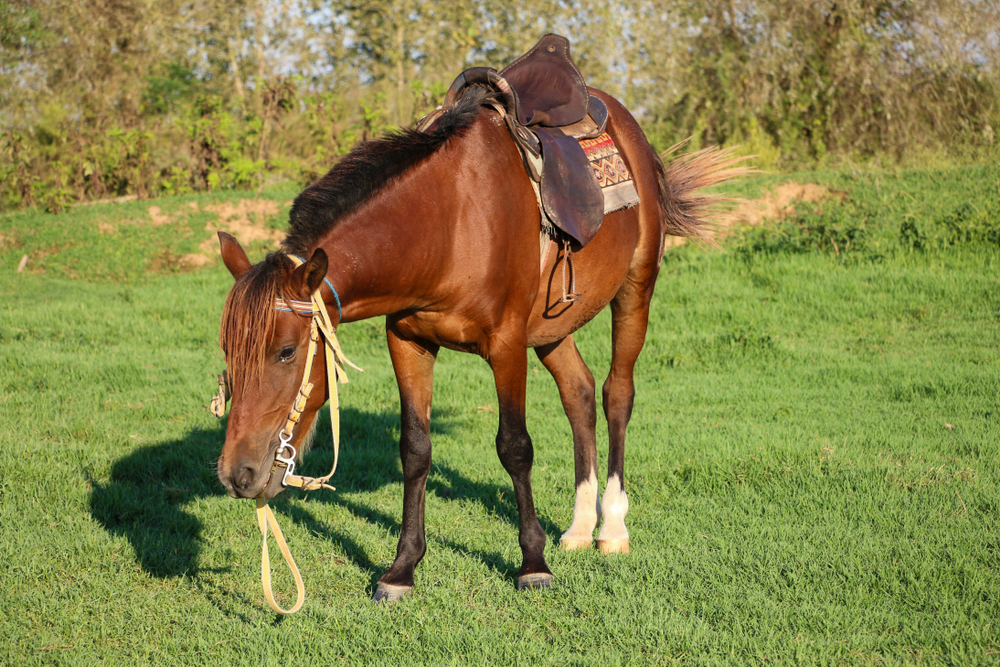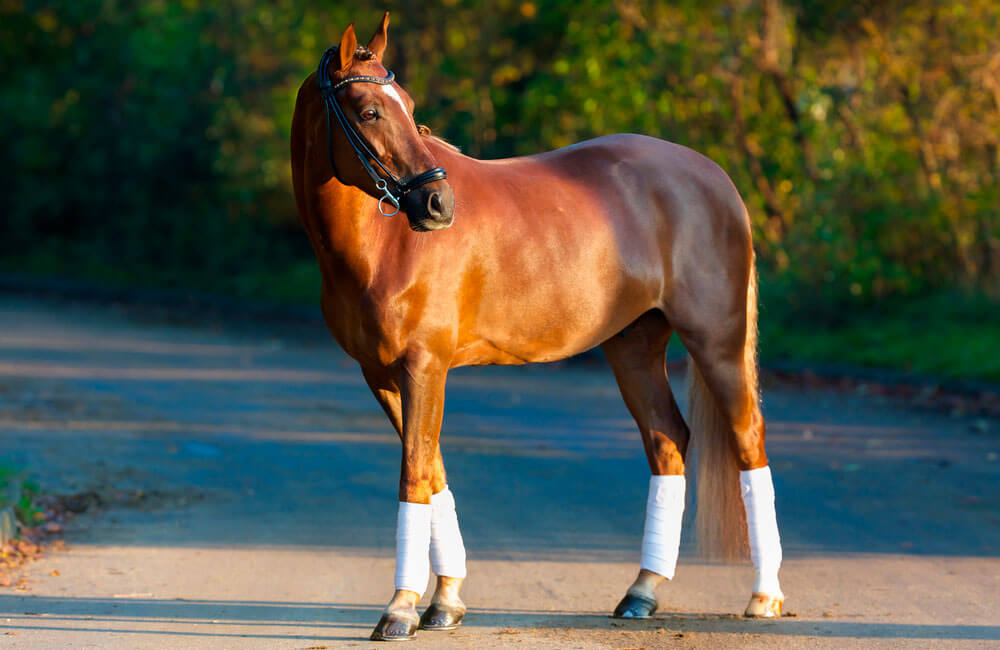
The Turkoman Horse or Turkmene is an extinct horse breed. It’s an Oriental horse from the steppers of a desert called Turkoman. The Turkoman partook in breeding a range of horses. It influenced several breeds including the Akhal-Teke Horse, Thoroughbred, Yomud, Goklan, and Nokhorli. With Turkoman’s fantastic health, good stamina, and also their sleek coat, these horses were a symbol of prestige and power.
Here’s a detailed review of the Turkoman Horse breed and its interesting facts.
Turkoman Horse History
The Turkoman Horse or Turkmene was an Oriental horse from Central Asia created by ancient breeders. Turkoman Horses were kept in semi-wild conditions. Equines had to look for shelter and food on their own. Animals had to defend themselves from predators and bad weather.
Breeders used to catch 6-month-old colts (young male horses) to start training. Owners got Turkoman Horses used to the halter and leading ropes. Soon after, at the age of 8 months, the horse was already ridden under a saddle. A lightweight rider could handle young Turkoman Horses.
The Turkoman was primarily bred to take part in horse racing. By the age of one year, the equine was ready to race. Such animals featured their good temperament and endurance. These are excellent characteristics of racing horses.
The Turkmen Horse had specific nutrition for Oriental horses. It was fed with a diet rich in protein. It included barley, chicken, mutton fat, raisins, dates, and alfalfa.

The Ancestors of the Turkoman Oriental Horse
The Caspian Horse is believed to be the ancestor of the Turkoman Horse. It is a fascinating creature with a rich history that dates back over 2,000 years. Despite being one of the oldest equine breeds in the world, the Caspian Horse is also one of the rarest, with only a few hundred individuals remaining in existence today.
The Caspian Horse, also known as the Khazar Horse, is believed to have originated in the ancient kingdom of Khazar, which was located in the region of the Caspian Sea. The breed was first mentioned in historical records in 300 BC. The equine was prized for its speed, slender but agile build, and endurance. The Caspian Horse was the mount of choice as a war horse in the Khazar Kingdom, used in battle and for hunting. The Caspian breed was also highly regarded for its beauty and grace and was often featured in artwork and literature.
As the Khazar Kingdom declined, the Caspian Horse disappeared from the historical record. For years, it was believed to have become extinct. However, in 1965, a group of horse enthusiasts discovered a population of small horses in the northern region of Iran. They resembled the descriptions of the Caspian Horse in historical records. After extensive study, it was determined that these horses were, in fact, descendants of the ancient breed. Solid efforts were made to preserve and promote the Caspian Horse.
The Caspian Horse is a small breed, standing only 11-13 hands tall. It’s perfect for lightweight riders. The equine has a fine-boned structure, with a long, sloping shoulder, a deep chest, muscular legs, and a short back. The breed has a refined head with large, expressive eyes and small, curved ears. The Caspian Horse is known for its gentle disposition and its ability to form strong bonds with its owners.

Turkoman vs Arabian Horse
The Turkoman Horse may have a common pedigree with the Arabian Horse. The debates are still open, though. It’s believed horsemen kept the true Arabian pure to preserve the breed. Perhaps the Turkmen horse was kept pure for the same reason.
However, both Oriental horse breeds had a common ground in their history. Turkoman stallions were brought to the Caliph of Baghdad. They were likely to be bred with Arabian mares. Since the 17th century, the Arabian’s strain has occurred. This may have happened because of the Turkoman Horses.

Turkoman vs Thoroughbred
Turkoman Horses influenced many horse breeds, including the English Thoroughbred. The stallion called Byerley Turk was one of the founders of modern racing Thoroughbreds. It’s believed to have a connection with the Turkoman Horse.
On the other hand, some horsemen are against this theory. The records state “Turks” horses in the Weatherby’s General Stud Book. These animals were believed to Arabians, not Turkomen. These horses were Turks because they were taken as prizes from the Turkey – Crimea war. However, some sources state those Turks were related to Turkoman horses.
The Turkoman was brought to England by soldiers in the 19th century. The well-known stallion called Merv was kept by Baker Pasha. Merv was in high demand as well as the price for his services. He didn’t cover any mares in England. In 1877, Merv was sold to Ireland.

When Did the Turkoman Horse Go Extinct?
The Turkoman Horse went extinct in the early 18th century. The horse wasn’t included in breeding. Thus, the population went down. However, the Turkoman Horse developed other horse breeds. They included well-known Thoroughbred racing horses and the Akhal-Teke breed.
Some sources claim the Turkoman Horse still exists. The breed is kept in small herds in Iran. The horse is massive and sturdy to carry an armed soldier. Although, Akhal-Tekes from Pakistan has a lighter build.

Turkoman Horse Characteristics
The Turkoman horse was loved for its endurance and stamina. They featured a slender body with fine conformation. It was one of the toughest horses in the world. The Turkoman horse’s characteristics were a good fit to be used as race and war horses.
The head was well-proportioned. The profile was straight, and the neck was long with massive and sloping shoulders. The chest was broad. The back was long, and the quarters were sloping. The belly was tucked up. The legs were long and muscular. The joints were broad. The hooves were small but strong.
The average height of the Turkoman horse was 15 to 16 hands tall. The common coat colors included black, bay, chestnut, and grey.
Riders adore the Turkoman’s temperament. The horse was spirited and highly intelligent. It was bold and willing to work. Turkomen were commonly used for riding and racing.
Modern Descendants of the Turkoman Horse

Akhal-Teke
The Akhal-Teke horse came from Turkmenistan, Central Asia. Akhal-Tekes stands out with their great speed and endurance. They feature a coat of metallic sheen. Such animals are sometimes called Golden Horses because of their coat color. Apart from its country of origin, the breed is also spread among North America and Europe.
The Akhal-Teke is one of the oldest horse breeds. Those horses bred in the Kopet Dag mountains by a tribe of Turkmens. Akhal-Teke Horses were used for raiding and battles. It was a war horse in the fight against the Russian Empire.
The Russians closed the Akhal-Teke stud book in 1932. Only in 1941 the studbook was printed by the Soviet Union.

Characteristics
The Akhal-Teke Horse height is 14.2 to 16 hands tall. The weight is 900 to 1,000 pounds on average.
The head is refined with a straight profile. The ears are long with almond-shaped eyes. The neck is upright with sloping shoulders. The skin is thin. The mane and tail are sparse. The back is long and muscled. The croup is long and flat.
Akhal-Teke horses are easy to recognize by their buckskin and palomino colors. They may also come in black, bay, chestnut, and grey.
The Akhal-Teke is an easy-keeper. As the horse was bred in the mountainous regions, the animal must have survived with minimal feed. Thus, the breed is great for living in harsh conditions. The Akhal-Teke is commonly used in racing, dressage, show jumping, and eventing.

Thoroughbred
The Thoroughbred is a favorite among racing lovers. The horse is known for its gracefulness and fast speed. It’s commonly used in horse racing, jumping, and eventing. Being developed in England, this breed is greatly popular all over the world, particularly in the USA.
These are hot-blooded horses that are loved for their speed and agility. It was bred in England in the 17th century. Native mares were covered by Oriental stallions, including the Turkoman Horse.
The Thoroughbred influenced the breeding of other breeds. They include the American Standardbred, Quarter Horse, and Anglo-Arabian horses. Thoroughbreds are crossbred with warmblood equines due to their performance capabilities.

Characteristics
The Thoroughbred horse height is 15.2 to 17 hands tall. The average weight is 1,000 pounds.
The horse has a well-chiseled head. The neck is long and elegant. The body is short and slim. The chest is deep and broad. The hindquarters are deep. The coat is smooth. The limbs are long and lean but strong.
The common colors include bay, brown, black, chestnut, and grey. Roan, palomino, and white Thoroughbred horses are rare. There may have white markings on the face and lower limbs. Pinto horses are not allowed by the breed registry.

Turkoman Horse Breed Explained
The Turkoman Horse or Turkmene was the foundation of modern horse breeds. These are Akhal-Teke and English Thoroughbred horses. The bred was known for its great stamina and superb appearance.
Nowadays, the Turkoman has become extinct. However, some people believe the Akhal-Teke is the same breed. Nevertheless, Turkoman brought top-notch race horses to the world.
